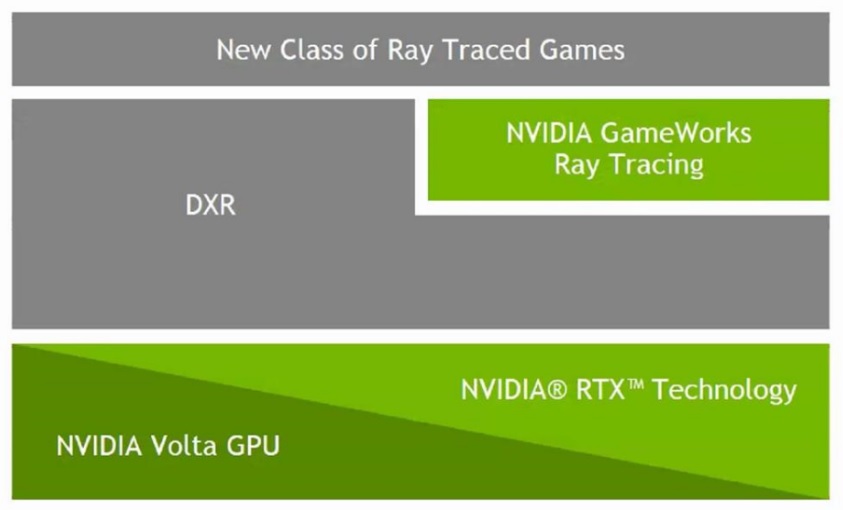Nvidia Reveals RTX Ray-Tracing Technology, New GameWorks SDK At GDC
Nvidia didn’t announce a new gaming graphics card at GDC, but it did give gamers a glimpse of the future with a new ray-tracing technology that runs on Microsoft’s new DirectX Raytracing (DXR) API.
What Is RTX?
Nvidia's RTX ray-tracing technology is a combination of software and hardware that allows applications (primarily games) to have real-time ray tracing effects, something long considered the holy grail of graphics processing.
Nvidia explained in a press release:
“Real-time ray tracing has been a dream of the graphics industry and game developers for decades, and Nvidia RTX is bringing it to life,” said Tony Tamasi, Senior Vice President of Content and Technology at Nvidia. “GPUs are only now becoming powerful enough to deliver real-time ray tracing for gaming applications, and will usher in a new era of next-generation visuals.”
RTX supports Microsoft’s new DirectX Raytracing API, so it can be utilized by the Windows OS. Industry leaders including 4A Games, Epic Games, Remedy Entertainment, and Unity each have an RTX technology demonstration on display at GDC, showcasing how real-time ray tracing can look in future games. The new DXR API is said to support the latest game engines, including Unreal Engine 4, Unity 5, and DICE’s Frostbite, and Nvidia claimed we would see games with the new technology hit shelves this year.
Nvidia said that the new RTX technology runs on “Volta architecture GPUs,” and further explained that RTX can function on GPUs that support the new Microsoft DirectX Raytracing API, indicating that Volta GPUs are currently the only ones in Nvidia’s catalog that run DXR. This leaves developers who are interested in using RTX technology a few expensive options: the Tesla V100 accelerator and Titan V. The new technology is clearly currently aimed at developers--Nvidia also announced a new GameWorks SDK for Ray Tracing that provides a suite of resources for game devs to integrate ray-traced area shadows, glossy reflections, and ambient occlusion into their titles.
Volta For Gaming?
Some have taken this as a sign that Nvidia has not abandoned plans for Volta-based GeForce (gaming) graphics cards, and when asked what the Volta architecture utilizes for RTX that previous architectures don’t have on a hardware level, the company declined to get into specifics at this time. However, if Nvidia is indeed readying completely new and segregated GPU architectures for consumer and client as the rumors suggest, it could be that Volta just clears some kind of hardware support cutoff that future architectures will also have.
Get Tom's Hardware's best news and in-depth reviews, straight to your inbox.
We’ve privately theorized that if Volta were to make it into a GeForce gaming graphics card lineup, Nvidia would have to eliminate or find a use for Volta’s tensor cores. Although they are optimized for deep learning workloads, tensor cores have also been adapted for use with AI-based denoising, and they could be ideal for ray tracing with its dedicated mixed-precision FP16/32 cores. RTX support may not have anything to do with Volta’s tensor cores, but with only the current snippet of Nvidia’s GeForce hardware future made clear, it’s certainly a possibility, and the announcement of Nvidia RTX just intensifies enthusiasts’ thirst for new graphics hardware.
Derek Forrest was a contributing freelance writer for Tom's Hardware. He covered hardware news and reviews, focusing on gaming desktops and laptops.
-
sinaptic Neat!Reply
Too bad no one can get a decent modern graphics card for less than double MSRP for the foreseeable future. or it might be more exciting. -
redgarl Another useless effect that will never be implemented because games are now developed for consoles and ported to PC. Kudos for the effect, but seriously it will be marginally used.Reply -
grimfox Interesting. I'm on the nV bandwagon at the moment but I do hope that AMD can reply to this development.Reply -
mac.haus.ch There was a second real-time ray tracing engine released today as well: https://venturebeat.com/2018/03/19/otoys-octane-4-blends-cinematic-video-and-games-using-ai/Reply
OTOY also collaborated with ImgTec just before Apple dropped them. -
mihen Wasn't AMD showing demos of Real-Time ray-tracing since 2006? Also no longer the holy grail in 3D rendering. Bouncing light takes too long and isn't too accurate going through certain materials. Now its bouncing sending a ray from the pixel until it bounces a certain amount or leaves the scene.Reply -
grimfox Reply20809776 said:Wasn't AMD showing demos of Real-Time ray-tracing since 2006? Also no longer the holy grail in 3D rendering. Bouncing light takes too long and isn't too accurate going through certain materials. Now its bouncing sending a ray from the pixel until it bounces a certain amount or leaves the scene.
Everyone's been demoing the tech for awhile. Last year (CES or maybe GDC) Imagination was demoing a 15W chip that was trouncing a GTX980 (IIRC) in rendering a scene using their ray tracing technology. The imagination chip was rendering the scene nearly instantly while the 980 took 5-10 seconds. Still, not many have been integrating the tech into engines or GPUs. It is possible to ray trace on modern cards, but not in real time. We still haven't a clue how good the technology is going to be. Unless we are to believe the leading image is a screen grab from a live demo.
link to imagination article(I did not remember some details correctly):
http://www.tomshardware.com/news/powervr-ray-tracing-console-graphics,31411.html


